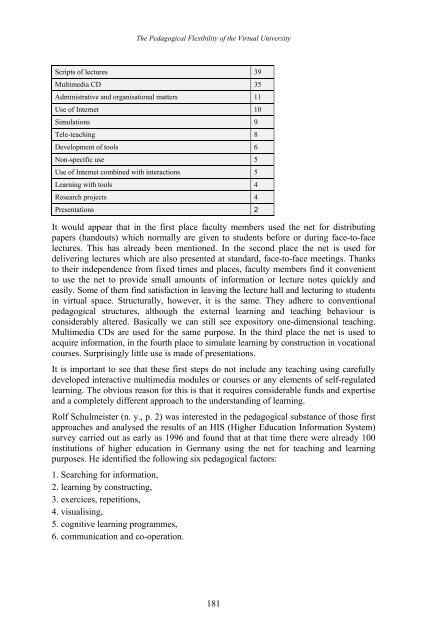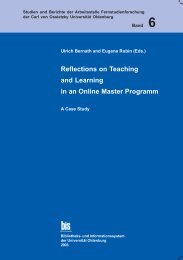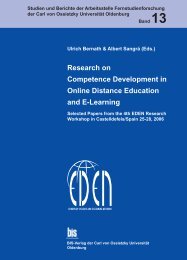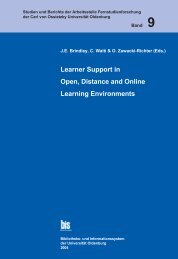Distance Education in Transition - Master of Distance Education ...
Distance Education in Transition - Master of Distance Education ...
Distance Education in Transition - Master of Distance Education ...
Create successful ePaper yourself
Turn your PDF publications into a flip-book with our unique Google optimized e-Paper software.
The Pedagogical Flexibility <strong>of</strong> the Virtual University<br />
Scripts <strong>of</strong> lectures 39<br />
Multimedia CD 35<br />
Adm<strong>in</strong>istrative and organisational matters 11<br />
Use <strong>of</strong> Internet 10<br />
Simulations 9<br />
Tele-teach<strong>in</strong>g 8<br />
Development <strong>of</strong> tools 6<br />
Non-specific use 5<br />
Use <strong>of</strong> Internet comb<strong>in</strong>ed with <strong>in</strong>teractions 5<br />
Learn<strong>in</strong>g with tools 4<br />
Research projects 4<br />
Presentations 2<br />
It would appear that <strong>in</strong> the first place faculty members used the net for distribut<strong>in</strong>g<br />
papers (handouts) which normally are given to students before or dur<strong>in</strong>g face-to-face<br />
lectures. This has already been mentioned. In the second place the net is used for<br />
deliver<strong>in</strong>g lectures which are also presented at standard, face-to-face meet<strong>in</strong>gs. Thanks<br />
to their <strong>in</strong>dependence from fixed times and places, faculty members f<strong>in</strong>d it convenient<br />
to use the net to provide small amounts <strong>of</strong> <strong>in</strong>formation or lecture notes quickly and<br />
easily. Some <strong>of</strong> them f<strong>in</strong>d satisfaction <strong>in</strong> leav<strong>in</strong>g the lecture hall and lectur<strong>in</strong>g to students<br />
<strong>in</strong> virtual space. Structurally, however, it is the same. They adhere to conventional<br />
pedagogical structures, although the external learn<strong>in</strong>g and teach<strong>in</strong>g behaviour is<br />
considerably altered. Basically we can still see expository one-dimensional teach<strong>in</strong>g.<br />
Multimedia CDs are used for the same purpose. In the third place the net is used to<br />
acquire <strong>in</strong>formation, <strong>in</strong> the fourth place to simulate learn<strong>in</strong>g by construction <strong>in</strong> vocational<br />
courses. Surpris<strong>in</strong>gly little use is made <strong>of</strong> presentations.<br />
It is important to see that these first steps do not <strong>in</strong>clude any teach<strong>in</strong>g us<strong>in</strong>g carefully<br />
developed <strong>in</strong>teractive multimedia modules or courses or any elements <strong>of</strong> self-regulated<br />
learn<strong>in</strong>g. The obvious reason for this is that it requires considerable funds and expertise<br />
and a completely different approach to the understand<strong>in</strong>g <strong>of</strong> learn<strong>in</strong>g.<br />
Rolf Schulmeister (n. y., p. 2) was <strong>in</strong>terested <strong>in</strong> the pedagogical substance <strong>of</strong> those first<br />
approaches and analysed the results <strong>of</strong> an HIS (Higher <strong>Education</strong> Information System)<br />
survey carried out as early as 1996 and found that at that time there were already 100<br />
<strong>in</strong>stitutions <strong>of</strong> higher education <strong>in</strong> Germany us<strong>in</strong>g the net for teach<strong>in</strong>g and learn<strong>in</strong>g<br />
purposes. He identified the follow<strong>in</strong>g six pedagogical factors:<br />
1. Search<strong>in</strong>g for <strong>in</strong>formation,<br />
2. learn<strong>in</strong>g by construct<strong>in</strong>g,<br />
3. exercices, repetitions,<br />
4. visualis<strong>in</strong>g,<br />
5. cognitive learn<strong>in</strong>g programmes,<br />
6. communication and co-operation.<br />
181





